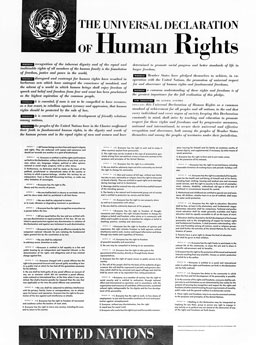
The UDHR was adopted by the UN General Assembly on 10 December 1948. After the end of WWII, the international community vowed never to allow atrocities like those of that conflict to happen again. The United Nations was founded and world leaders decided to complement the UN Charter with a road map to guarantee the rights of every individual everywhere. This road map become the Universal Declaration of Human Rights (it is a declaration and not a Treaty).
Whereas recognition of the inherent dignity and of the equal and inalienable rights of all members of the human family is the foundation of freedom, justice and peace in the world,
Whereas disregard and contempt for human rights have resulted in barbarous acts which have outraged the conscience of mankind, and the advent of a world in which human beings shall enjoy freedom of speech and belief and freedom from fear and want has been proclaimed as the highest aspiration of the common people,
Whereas it is essential, if man is not to be compelled to have recourse, as a last resort, to rebellion against tyranny and oppression, that human rights should be protected by the rule of law,
Whereas it is essential to promote the development of friendly relations between nations,
Whereas the peoples of the United Nations have in the Charter reaffirmed their faith in fundamental human rights, in the dignity and worth of the human person and in the equal rights of men and women and have determined to promote social progress and better standards of life in larger freedom,
Whereas Member States have pledged themselves to achieve, in co-operation with the United Nations, the promotion of universal respect for and observance of human rights and fundamental freedoms,
Whereas a common understanding of these rights and freedoms is of the greatest importance for the full realization of this pledge,
Now, Therefore THE GENERAL ASSEMBLY proclaims THIS UNIVERSAL DECLARATION OF HUMAN RIGHTS as a common standard of achievement for all peoples and all nations, to the end that every individual and every organ of society, keeping this Declaration constantly in mind, shall strive by teaching and education to promote respect for these rights and freedoms and by progressive measures, national and international, to secure their universal and effective recognition and observance, both among the peoples of Member States themselves and among the peoples of territories under their jurisdiction.
The UDHR was drafted around four pillars – dignity, liberty, equality and brotherhood. Each pillar represents an ideal considered essential to the enjoyment of an individual’s life in their community. Protected human rights link back to these pillars:
Though these have been long-standing pillars, it does not mean that there is absolute agreement on these four pillars being the only encapsulation of rights. An argument often lodged against international human rights is that they reflect the ideals of capitalist, Western societies. Many cultures maintain different views of rights, particularly those that are traditionally not in a free-market economy or that are governed by non-democratic traditions or religious laws. In fact, social scientists have long pointed out that many cultures, such as the Mayans of Central America, do not actually have a word that translates into anything resembling rights (Pitarch et al. 2008).

Figure 2 is a picture of the Universal Declaration of Human Rights.
Figure 2The Universal Declaration of Human RightsShould you wish to read the UDHR in more detail a PDF version is available via this link: Universal Declaration of Human Rights [ Tip: hold ⌘ and click a link to open it in a new tab. (Hide tip) ] .
The UDHR is one of the world’s most translated documents yet it does not have the force of law, rather it sets aspirations.
Take your learning furtherMaking the decision to study can be a big step, which is why you’ll want a trusted University. We’ve pioneered distance learning for over 50 years, bringing university to you wherever you are so you can fit study around your life. Take a look at all Open University courses.
If you’re new to university-level study, read our guide on Where to take your learning next, or find out more about the types of qualifications we offer including entry level Access modules, Certificates, and Short Courses.
Want to achieve your ambition? Study with us and you’ll be joining over 2 million students who’ve achieved their career and personal goals with The Open University.